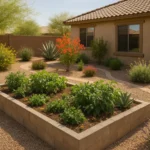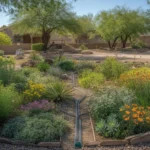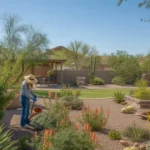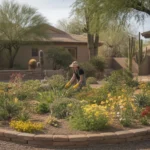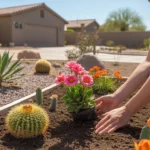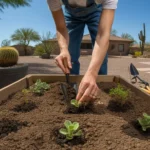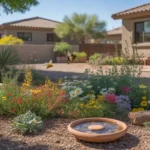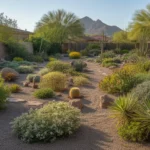Raised bed gardening is a popular choice for Gilbert residents looking to maximize their growing space and enjoy homegrown harvests. To ensure your raised beds thrive in the desert climate, there are several essential tasks to tackle. With a bit of preparation and know-how, you can set your raised bed garden up for success and enjoy bountiful crops season after season.

Choose the Right Location
One of the most important decisions when starting a raised bed garden in Gilbert is selecting the ideal spot. Look for an area that receives at least 6-8 hours of direct sunlight daily, as most vegetables and herbs require ample sun to thrive. Consider the proximity to your home for easy access and maintenance, as well as the availability of water for irrigation.
If possible, choose a level area to simplify the construction process and ensure even water distribution. Avoid low-lying spots prone to flooding or areas with poor drainage, as raised beds can become waterlogged if not properly situated. By carefully selecting the location for your raised beds, you’ll create a strong foundation for a thriving garden.
🛠 Build Sturdy Beds for the Desert
When constructing your raised beds in Gilbert, it’s best to choose materials that can stand up to intense heat, strong UV rays, and the occasional monsoon downpour. While untreated wood like cedar or redwood is rot-resistant in milder climates, it often deteriorates quickly in Arizona’s extreme conditions—warping, cracking, or breaking down within a few seasons.
Instead, many local gardeners opt for more durable alternatives like corrugated metal panels, concrete blocks, or composite lumber. These materials withstand the desert environment far better and offer long-term stability with minimal maintenance.
For most vegetables and herbs, aim for beds that are 6 to 12 inches deep. If you’re planting root crops like carrots or potatoes, consider going up to 18 inches. Keep each bed no more than 4 feet wide so you can easily reach the center from either side without stepping on the soil, which can compact it and inhibit plant growth.
Invest in Quality Soil
The key to a thriving raised bed garden in Gilbert lies in the soil. Unlike traditional in-ground gardens, raised beds allow you to start with a blank slate and create the ideal growing medium for your plants. Begin by filling your beds with a high-quality, well-draining soil mix specifically formulated for raised bed gardening.
Look for a mix that contains a balanced blend of organic matter, such as compost or well-rotted manure, along with ingredients like perlite or vermiculite to improve drainage and aeration. Avoid using soil directly from your yard, as it may contain weed seeds, pests, or diseases that can hinder your plants’ growth. By investing in premium soil, you’ll give your crops the best possible start and promote healthy root development.
Install Efficient Irrigation
Proper watering is crucial for the success of your raised bed garden in Gilbert’s arid climate. Hand watering can be time-consuming and inconsistent, so consider installing an efficient irrigation system to ensure your plants receive the moisture they need to thrive. Drip irrigation is an excellent option for raised beds, as it delivers water directly to the roots and minimizes evaporation.
When setting up your irrigation system, use high-quality components designed for the rigors of desert gardening. Choose durable tubing and emitters that can withstand the heat and sun exposure. Install a timer to automate your watering schedule and adjust it based on the season and your plants’ needs. By providing consistent moisture, you’ll promote healthy growth and reduce water waste.
Mulch to Conserve Moisture
Mulching your raised beds is a simple yet effective way to conserve moisture, regulate soil temperature, and suppress weed growth. Apply a 2-3 inch layer of organic mulch, such as straw, shredded leaves, or bark chips, around your plants. As the mulch breaks down, it will also add nutrients to the soil and improve its structure.
Be sure to keep the mulch a few inches away from the base of your plants to prevent stem rot and other issues. Replenish the mulch as needed throughout the growing season to maintain its benefits. By mulching your raised beds, you’ll create a more resilient and low-maintenance garden that can better withstand Gilbert’s challenging climate.
Implement Companion Planting
Companion planting is a time-honored technique that involves growing specific plants together to enhance growth, deter pests, and improve overall garden health. By strategically placing complementary crops in your raised beds, you can create a more diverse and resilient ecosystem that benefits all your plants.
For example, planting basil alongside tomatoes can help repel pests and improve flavor. Marigolds, when planted throughout your garden, can deter nematodes and other soil-borne pests. Legumes, such as beans and peas, fix nitrogen in the soil, making it available for neighboring plants. By embracing companion planting in your Gilbert raised bed garden, you’ll promote natural pest control, reduce the need for synthetic inputs, and create a more harmonious growing environment.
Monitor and Maintain
Regular monitoring and maintenance are essential for keeping your raised bed garden healthy and productive. Make a habit of checking your plants daily for signs of stress, pests, or disease. Remove any damaged or diseased foliage promptly to prevent the spread of issues throughout your garden.
Keep an eye on soil moisture levels and adjust your watering schedule as needed, especially during Gilbert’s scorching summer months. Regularly prune and harvest your crops to encourage continued growth and prevent plants from becoming overcrowded. By staying vigilant and proactive in your garden maintenance, you’ll catch potential problems early and ensure your raised beds remain vibrant and productive.
With these must-do tasks, you’ll be well on your way to creating a thriving raised bed garden in Gilbert. By investing time and effort into proper planning, construction, and maintenance, you’ll enjoy the rewards of homegrown harvests and a beautiful outdoor space for seasons to come. Happy gardening!

